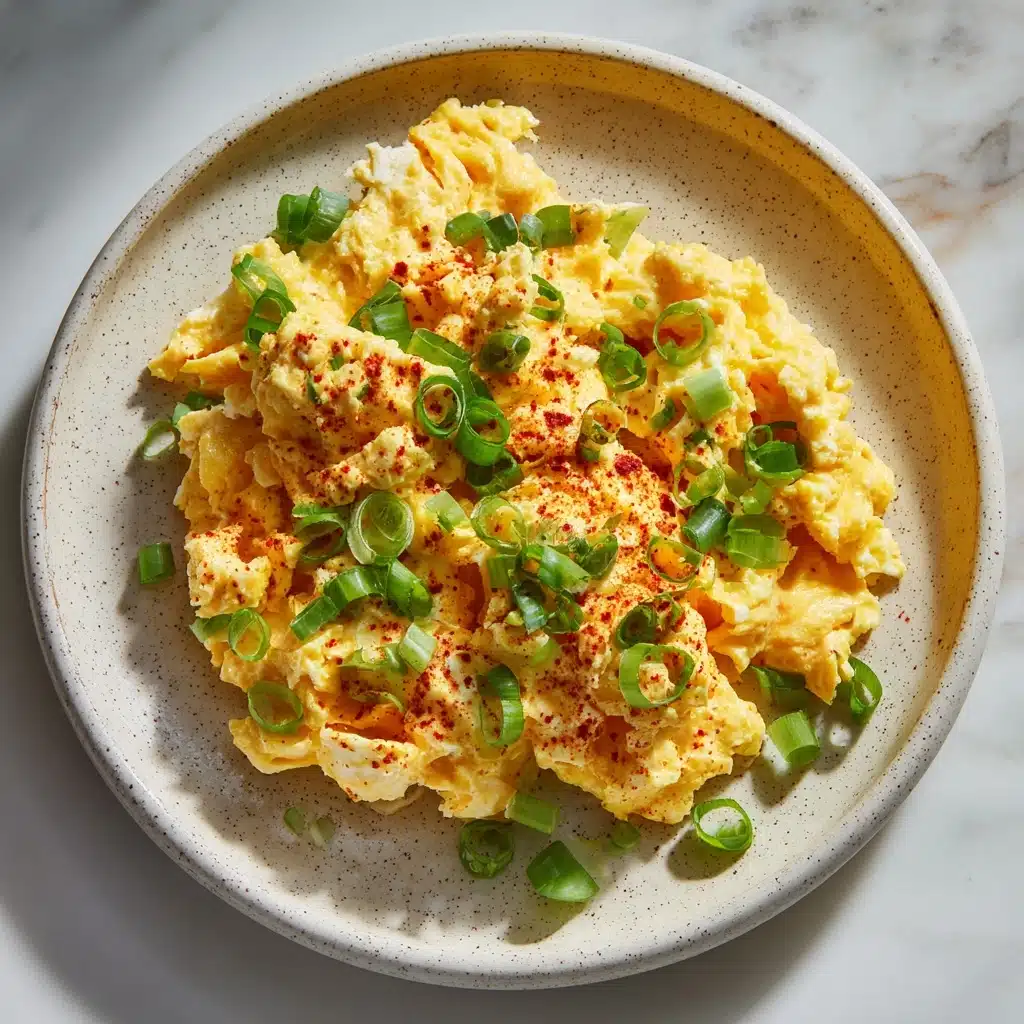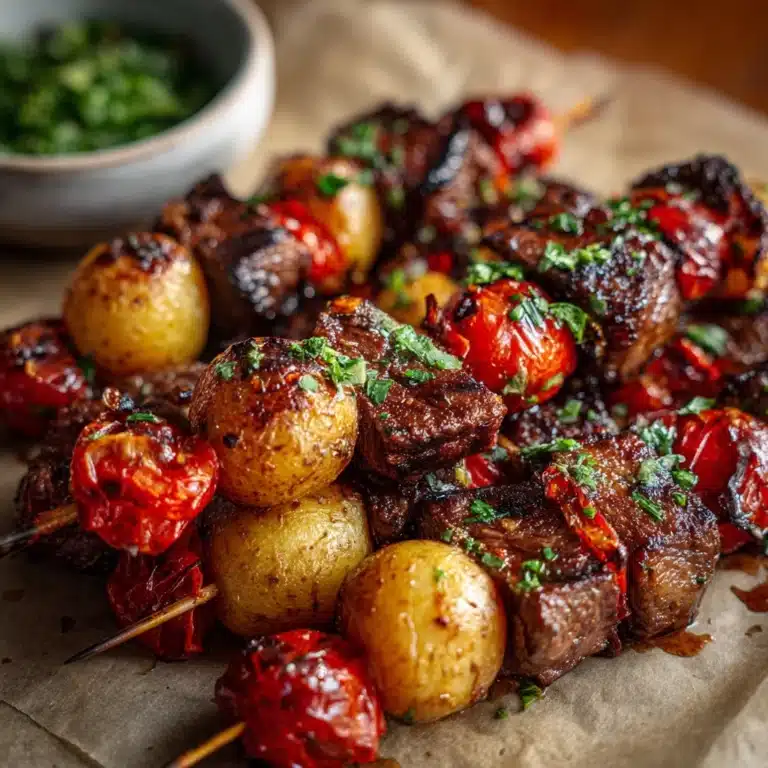Gochujang Scrambled Eggs Recipe
If you’re looking to add a fiery spark to your morning routine, these Gochujang Scrambled Eggs are about to become your new breakfast obsession. Creamy, cloud-soft eggs get an irresistible lift from gochujang, Korea’s iconic chili paste, with just the right hint of warmth and umami. Balanced with butter, sesame, and a pop of freshness from green onions, every bite is pure comfort with a twist. Whether you’re a late sleeper craving an exciting brunch or in need of a quick but memorable meal, this recipe delivers an explosion of flavor in only minutes—no fancy ingredients required, just a little curiosity and a love for delicious simplicity.

Ingredients You’ll Need
Each ingredient in these Gochujang Scrambled Eggs is purposefully chosen to create a blend of creamy texture, gentle heat, and irresistible aroma. You don’t need a long list—just these approachable staples. Here’s how each one brings its magic to the pan:
- Eggs: The undeniable star of the show, providing a fluffy canvas for all the bold flavors.
- Milk or Water: Adds a touch of moisture, helping achieve silkier, lighter scrambled eggs.
- Sesame Oil: Infuses the eggs with a nutty depth and distinctly Korean aroma—just a teaspoon works wonders.
- Gochujang: The soul of this dish, bringing gentle heat, sweetness, and a rich, umami punch.
- Butter: Lends creamy richness and helps the eggs cook gently without sticking.
- Green Onion: Sliced thin for a fresh, almost peppery bite—your pop of color and flavor.
- Salt and Pepper: Essential finishing touches to enhance and balance all of the flavors.
- Toasted Sesame Seeds: Added at the end for an appealing crunch and a little extra nuttiness.
How to Make Gochujang Scrambled Eggs
Step 1: Whisk the Egg Mixture
Start by cracking your eggs into a medium bowl. Add in the milk (or water), sesame oil, and that beautiful tablespoon of gochujang. This is the moment when creamy and spicy begin to mingle! Whisk vigorously until the mixture is smooth and the gochujang is thoroughly combined—the color should be a gorgeous, light brick-red. Don’t rush this part; a well-mixed base gives you the fluffiest scrambled eggs later.
Step 2: Melt the Butter
Place a non-stick skillet over medium-low heat and add the butter. Allow it to melt gently and start bubbling, but don’t let it brown. Swirl the pan so the butter coats the bottom, setting the stage for a perfectly soft scramble. A lower heat ensures you won’t overcook your eggs; patience pays off with extra creaminess!
Step 3: Scramble the Eggs Slowly
Pour the well-whisked egg mixture into your prepared pan. Let it sit undisturbed for a few seconds so the bottom gently begins to set—this moment is crucial for pillowy eggs. With a soft spatula, slowly stir from the edges toward the center, creating large, tender curds. Continue stirring occasionally, keeping the heat low. For Gochujang Scrambled Eggs, slow is best; you want them glossy and barely set for the richest texture.
Step 4: Season and Finish
Once the eggs are mostly set but still slightly runny, season lightly with salt and pepper. Remove the pan from the heat; the residual warmth will finish cooking them to absolute perfection. This gentle finish keeps the scramble creamy, never dry, and ensures all that gochujang flavor shines through.
Step 5: Garnish and Serve
Transfer your Gochujang Scrambled Eggs to plates or a warm platter. Sprinkle generously with sliced green onions and a scattering of toasted sesame seeds. That vivid green and snowy white pop against the red-tinted eggs, making breakfast look just as exciting as it tastes!
How to Serve Gochujang Scrambled Eggs

Garnishes
Garnishing is where you get to turn breakfast into a small celebration. A scattering of extra green onion and a handful of toasted sesame seeds bring freshness and crunch right to the top. For an extra-special finish, add a pinch of sea salt flakes, a drizzle of chili oil, or even a sprinkle of crushed roasted seaweed for more of a Korean flair.
Side Dishes
Gochujang Scrambled Eggs are wonderful on their own, but they’re even better with supporting acts! Steamed white rice is a classic choice, soaking up any saucy bits. A slice of crusty sourdough or a buttered English muffin works well if you’re feeling Western, while a simple cucumber salad or pickled veggies add balance and zing alongside the heat and richness of the eggs.
Creative Ways to Present
Serve these vibrant scrambled eggs as a filling for breakfast tacos, wrapped in warm tortillas with avocado slices and kimchi. Pile them on top of a bed of baby spinach for a Korean-inspired egg bowl, or even spoon them over toasted nori sheets for a playful take on sushi. A sprinkle of furikake or some microgreens transforms them into an impressive brunch centerpiece.
Make Ahead and Storage
Storing Leftovers
If you find yourself with extra Gochujang Scrambled Eggs (though let’s be honest, that’s a rare blessing), let them cool completely before transferring to an airtight container. They’ll keep happily in the refrigerator for up to two days. To keep them tasting their best, try to store the garnishes separately and top fresh when you’re ready to eat.
Freezing
While eggs, especially scrambled, can be unpredictable after freezing, these Gochujang Scrambled Eggs will hold up surprisingly well. Spoon cooled eggs into freezer-safe bags or containers, pressing out as much air as possible. Label, seal, and freeze for up to one month. Expect the texture to be a bit softer after thawing, but the bold flavor remains delicious.
Reheating
To reheat, let frozen eggs thaw in the fridge overnight. Gently warm in a non-stick skillet over low heat, adding a splash of milk or water to help loosen and refresh the scramble. Avoid using high heat, which can toughen eggs. Microwave reheating works too—just stir every 20 seconds until heated through, then add fresh garnishes to restore that brightness.
FAQs
Are Gochujang Scrambled Eggs very spicy?
Not overwhelmingly! Gochujang has a mild heat with a sweet, savory undertone. You can easily adjust the spice level by adding more or less gochujang to suit your taste without sacrificing the overall flavor.
Can I make this dish dairy-free?
Absolutely! Swap butter for a neutral oil or more sesame oil, and use water instead of milk. The eggs will still turn out creamy and the Korean-inspired taste will shine through beautifully.
What can I use if I don’t have gochujang?
Nothing can truly mimic the exact taste, but a mix of sriracha, a touch of miso, and a pinch of sugar gets you close. The result won’t be the same, but it will still bring a bit of that signature spicy, umami character.
How do I make the eggs fluffier?
Be sure to whisk the eggs thoroughly so plenty of air gets incorporated, and cook low and slow. The addition of milk or water helps keep things light, but less stirring and patience are what make truly soft, fluffy Gochujang Scrambled Eggs.
Can I add extra veggies or protein?
Definitely! Toss in some sautéed spinach, diced bell peppers, or cooked mushrooms to the pan right before adding the eggs. Leftover shredded chicken or a handful of crumbled tofu also blend in seamlessly for a heartier meal.
Final Thoughts
If you love exploring new breakfast flavors, Gochujang Scrambled Eggs are an absolute must-try. They’re creamy, just spicy enough, and endlessly customizable for mornings, brunches, or even lazy late-night cravings. Whip up a batch, sprinkle on some green onions, and dig in—you might just find yourself hooked!
Print
Gochujang Scrambled Eggs Recipe
- Total Time: 10 minutes
- Yield: 2 servings 1x
- Diet: Vegetarian
Description
These Gochujang Scrambled Eggs are a flavorful twist on classic scrambled eggs, infused with Korean chili paste for a spicy kick. Creamy and rich with a hint of sesame, they make a delicious and satisfying breakfast option.
Ingredients
Eggs:
- 4 large eggs
Liquid:
- 1 tablespoon milk or water
Seasonings:
- 1 teaspoon sesame oil
- 1 tablespoon gochujang (Korean chili paste)
- Salt and pepper to taste
Others:
- 1 tablespoon unsalted butter
- 1 green onion, thinly sliced
- Toasted sesame seeds for garnish
Instructions
- Prepare Egg Mixture: In a bowl, whisk together eggs, milk or water, sesame oil, and gochujang until fully combined.
- Cook Eggs: Heat butter in a non-stick skillet over medium-low heat. Pour in the egg mixture and let it sit undisturbed for a few seconds. Gently stir with a spatula, pushing eggs from the edges to the center, cooking slowly until soft and creamy.
- Season and Serve: Season with salt and pepper. Remove from heat just before fully set to keep eggs moist. Serve topped with sliced green onions and toasted sesame seeds.
Notes
- Adjust gochujang amount to your spice preference.
- For extra flavor, add a splash of soy sauce or a sprinkle of toasted seaweed flakes.
- Serve with steamed rice or crusty bread.
- Prep Time: 5 minutes
- Cook Time: 5 minutes
- Category: Breakfast
- Method: Stovetop
- Cuisine: Korean-inspired
Nutrition
- Serving Size: 2 eggs
- Calories: 210
- Sugar: 2 g
- Sodium: 380 mg
- Fat: 16 g
- Saturated Fat: 6 g
- Unsaturated Fat: 9 g
- Trans Fat: 0 g
- Carbohydrates: 3 g
- Fiber: 0 g
- Protein: 14 g
- Cholesterol: 370 mg






